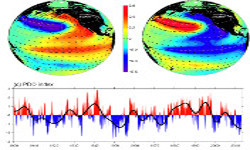Decadal Variability
Observed and projected climate variations are both a response to human-induced radiative forcing changes and part of the natural variability of the climate system. Characterizing and understanding natural variability of the climate system is critical for determining which aspects of observed climate variations are due to human activity, as well as for improving our ability to predict and project future changes. Variations on decadal to multidecadal time scales are particularly important, as this is also the time scale on which anthropogenic climate change emerges. One of the important components for decadal variations in the climate system is the Atlantic Meridional Overturning Circulation.
Listed below is a section of research papers focused on various aspects of decadal climate variability.
Atlantic Decadal to Multidecadal Mariability
The North Atlantic Oscillation as a driver of rapid climate change (Delworth et al., 2016)
Early work on interdecadal variability of the AMOC (Delworth et al., 1993)
Pacific Decadal Oscillation
How does the PDO change under Global Warming? (Zhang and Delworth, 2016)
Characteristics and mechanisms of PDO variability in a suite of GFDL climate models (Zhang and Delworth, 2015)
Decadal to Centennial Variability in the Southern Ocean
Simulated impact of the Weddell Gyre on Antarctic Bottom Water (Zhang and Delworth, 2016)


